Erroll Wood
Learning to Stabilize Faces
Nov 22, 2024Abstract:Nowadays, it is possible to scan faces and automatically register them with high quality. However, the resulting face meshes often need further processing: we need to stabilize them to remove unwanted head movement. Stabilization is important for tasks like game development or movie making which require facial expressions to be cleanly separated from rigid head motion. Since manual stabilization is labor-intensive, there have been attempts to automate it. However, previous methods remain impractical: they either still require some manual input, produce imprecise alignments, rely on dubious heuristics and slow optimization, or assume a temporally ordered input. Instead, we present a new learning-based approach that is simple and fully automatic. We treat stabilization as a regression problem: given two face meshes, our network directly predicts the rigid transform between them that brings their skulls into alignment. We generate synthetic training data using a 3D Morphable Model (3DMM), exploiting the fact that 3DMM parameters separate skull motion from facial skin motion. Through extensive experiments we show that our approach outperforms the state-of-the-art both quantitatively and qualitatively on the tasks of stabilizing discrete sets of facial expressions as well as dynamic facial performances. Furthermore, we provide an ablation study detailing the design choices and best practices to help others adopt our approach for their own uses. Supplementary videos can be found on the project webpage syntec-research.github.io/FaceStab.
Cafca: High-quality Novel View Synthesis of Expressive Faces from Casual Few-shot Captures
Oct 01, 2024


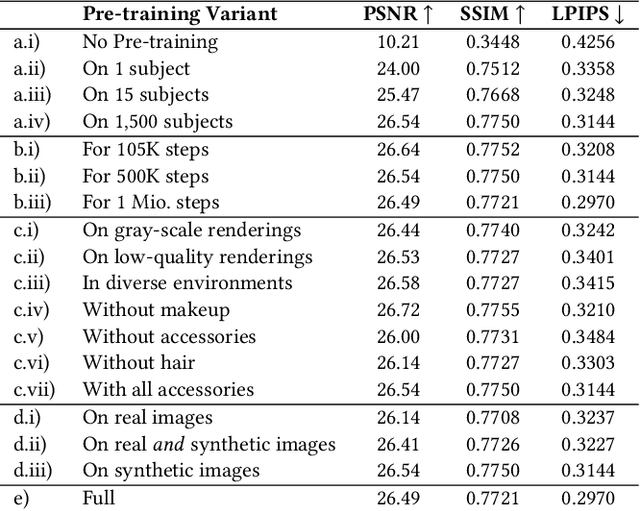
Abstract:Volumetric modeling and neural radiance field representations have revolutionized 3D face capture and photorealistic novel view synthesis. However, these methods often require hundreds of multi-view input images and are thus inapplicable to cases with less than a handful of inputs. We present a novel volumetric prior on human faces that allows for high-fidelity expressive face modeling from as few as three input views captured in the wild. Our key insight is that an implicit prior trained on synthetic data alone can generalize to extremely challenging real-world identities and expressions and render novel views with fine idiosyncratic details like wrinkles and eyelashes. We leverage a 3D Morphable Face Model to synthesize a large training set, rendering each identity with different expressions, hair, clothing, and other assets. We then train a conditional Neural Radiance Field prior on this synthetic dataset and, at inference time, fine-tune the model on a very sparse set of real images of a single subject. On average, the fine-tuning requires only three inputs to cross the synthetic-to-real domain gap. The resulting personalized 3D model reconstructs strong idiosyncratic facial expressions and outperforms the state-of-the-art in high-quality novel view synthesis of faces from sparse inputs in terms of perceptual and photo-metric quality.
Procedural Humans for Computer Vision
Jan 03, 2023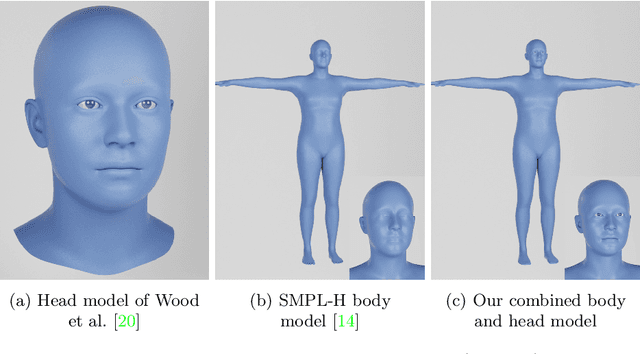
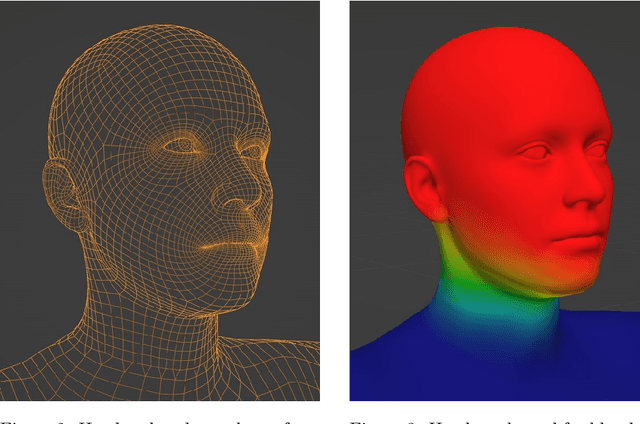
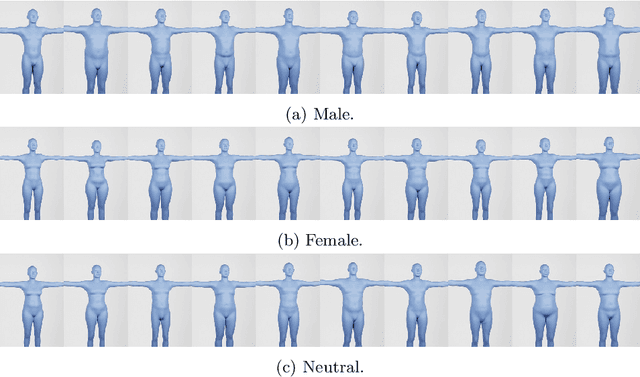
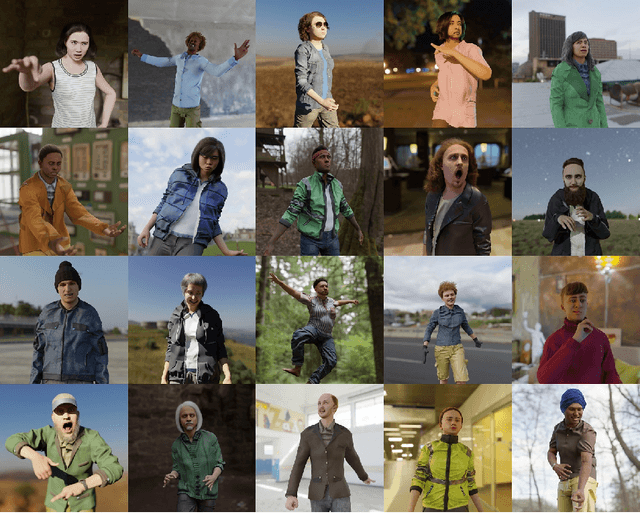
Abstract:Recent work has shown the benefits of synthetic data for use in computer vision, with applications ranging from autonomous driving to face landmark detection and reconstruction. There are a number of benefits of using synthetic data from privacy preservation and bias elimination to quality and feasibility of annotation. Generating human-centered synthetic data is a particular challenge in terms of realism and domain-gap, though recent work has shown that effective machine learning models can be trained using synthetic face data alone. We show that this can be extended to include the full body by building on the pipeline of Wood et al. to generate synthetic images of humans in their entirety, with ground-truth annotations for computer vision applications. In this report we describe how we construct a parametric model of the face and body, including articulated hands; our rendering pipeline to generate realistic images of humans based on this body model; an approach for training DNNs to regress a dense set of landmarks covering the entire body; and a method for fitting our body model to dense landmarks predicted from multiple views.
Mesh-Tension Driven Expression-Based Wrinkles for Synthetic Faces
Oct 05, 2022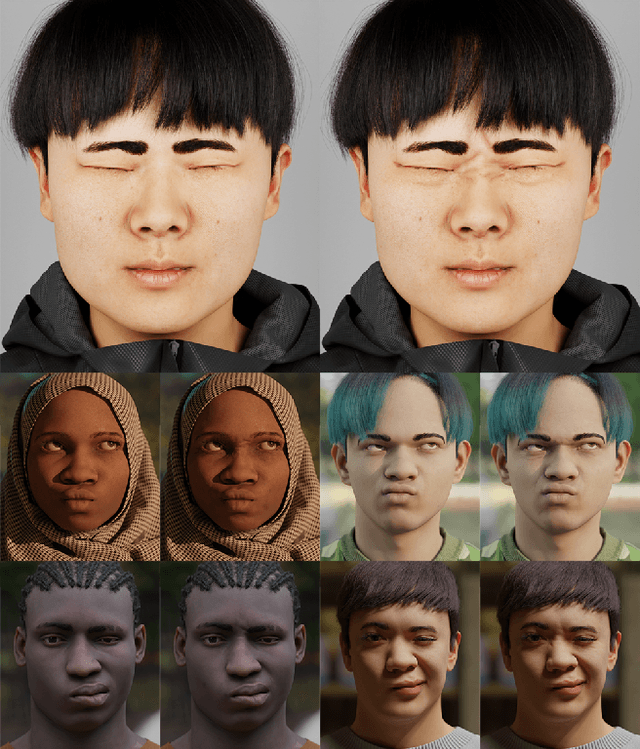
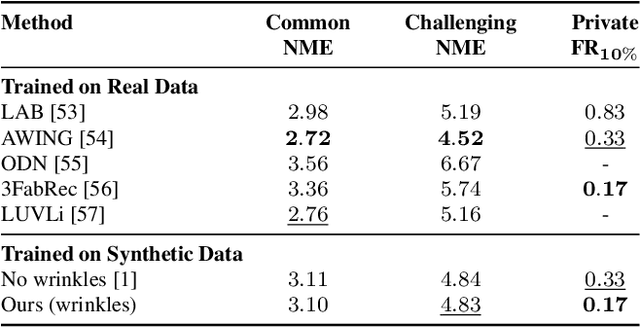

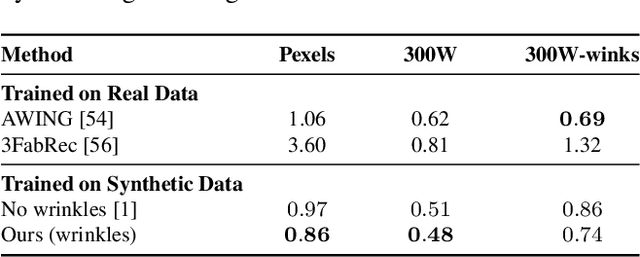
Abstract:Recent advances in synthesizing realistic faces have shown that synthetic training data can replace real data for various face-related computer vision tasks. A question arises: how important is realism? Is the pursuit of photorealism excessive? In this work, we show otherwise. We boost the realism of our synthetic faces by introducing dynamic skin wrinkles in response to facial expressions and observe significant performance improvements in downstream computer vision tasks. Previous approaches for producing such wrinkles either required prohibitive artist effort to scale across identities and expressions or were not capable of reconstructing high-frequency skin details with sufficient fidelity. Our key contribution is an approach that produces realistic wrinkles across a large and diverse population of digital humans. Concretely, we formalize the concept of mesh-tension and use it to aggregate possible wrinkles from high-quality expression scans into albedo and displacement texture maps. At synthesis, we use these maps to produce wrinkles even for expressions not represented in the source scans. Additionally, to provide a more nuanced indicator of model performance under deformations resulting from compressed expressions, we introduce the 300W-winks evaluation subset and the Pexels dataset of closed eyes and winks.
3D face reconstruction with dense landmarks
Apr 06, 2022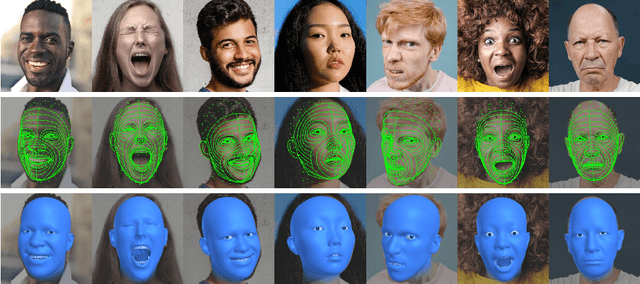



Abstract:Landmarks often play a key role in face analysis, but many aspects of identity or expression cannot be represented by sparse landmarks alone. Thus, in order to reconstruct faces more accurately, landmarks are often combined with additional signals like depth images or techniques like differentiable rendering. Can we keep things simple by just using more landmarks? In answer, we present the first method that accurately predicts 10x as many landmarks as usual, covering the whole head, including the eyes and teeth. This is accomplished using synthetic training data, which guarantees perfect landmark annotations. By fitting a morphable model to these dense landmarks, we achieve state-of-the-art results for monocular 3D face reconstruction in the wild. We show that dense landmarks are an ideal signal for integrating face shape information across frames by demonstrating accurate and expressive facial performance capture in both monocular and multi-view scenarios. This approach is also highly efficient: we can predict dense landmarks and fit our 3D face model at over 150FPS on a single CPU thread.
Synthetic Data for Multi-Parameter Camera-Based Physiological Sensing
Oct 10, 2021

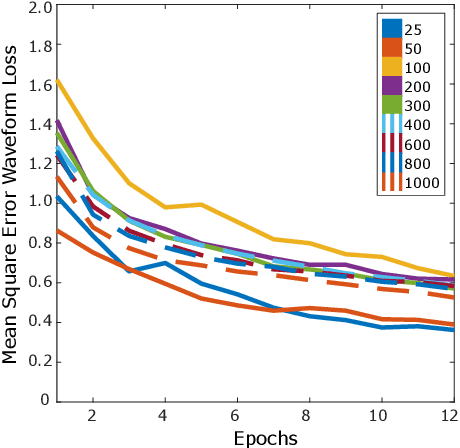
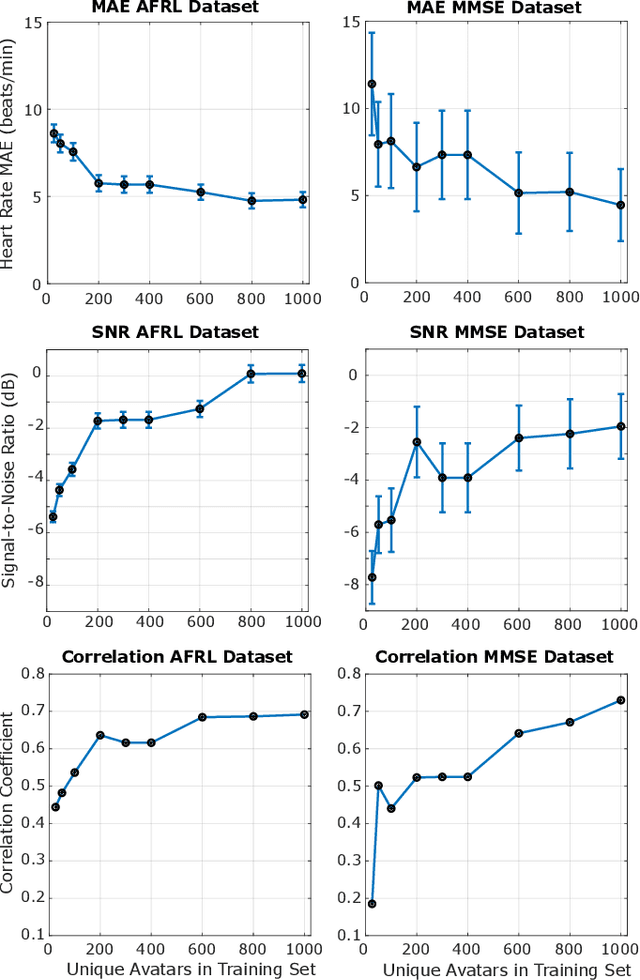
Abstract:Synthetic data is a powerful tool in training data hungry deep learning algorithms. However, to date, camera-based physiological sensing has not taken full advantage of these techniques. In this work, we leverage a high-fidelity synthetics pipeline for generating videos of faces with faithful blood flow and breathing patterns. We present systematic experiments showing how physiologically-grounded synthetic data can be used in training camera-based multi-parameter cardiopulmonary sensing. We provide empirical evidence that heart and breathing rate measurement accuracy increases with the number of synthetic avatars in the training set. Furthermore, training with avatars with darker skin types leads to better overall performance than training with avatars with lighter skin types. Finally, we discuss the opportunities that synthetics present in the domain of camera-based physiological sensing and limitations that need to be overcome.
Fake It Till You Make It: Face analysis in the wild using synthetic data alone
Oct 05, 2021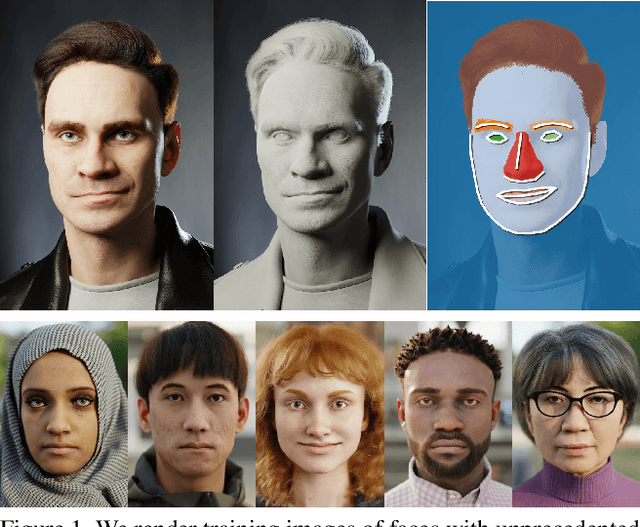


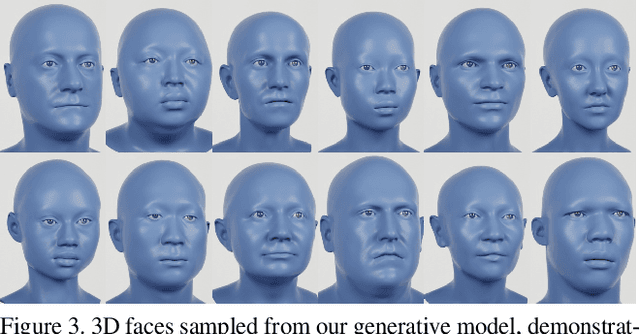
Abstract:We demonstrate that it is possible to perform face-related computer vision in the wild using synthetic data alone. The community has long enjoyed the benefits of synthesizing training data with graphics, but the domain gap between real and synthetic data has remained a problem, especially for human faces. Researchers have tried to bridge this gap with data mixing, domain adaptation, and domain-adversarial training, but we show that it is possible to synthesize data with minimal domain gap, so that models trained on synthetic data generalize to real in-the-wild datasets. We describe how to combine a procedurally-generated parametric 3D face model with a comprehensive library of hand-crafted assets to render training images with unprecedented realism and diversity. We train machine learning systems for face-related tasks such as landmark localization and face parsing, showing that synthetic data can both match real data in accuracy as well as open up new approaches where manual labelling would be impossible.
Advancing Non-Contact Vital Sign Measurement using Synthetic Avatars
Oct 24, 2020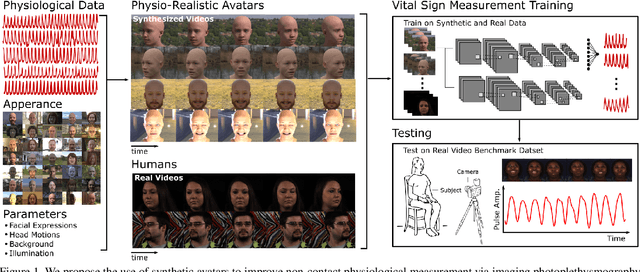
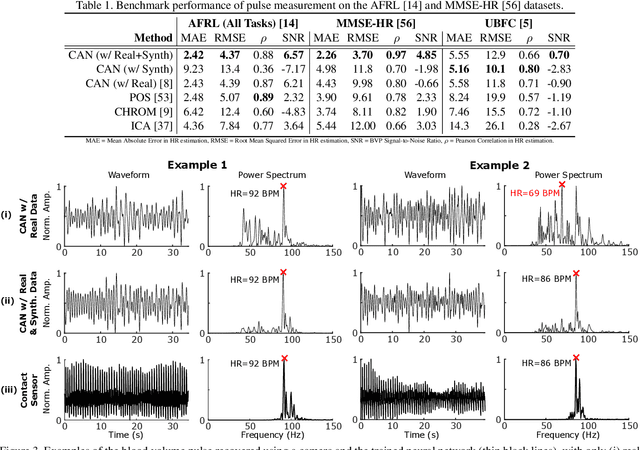

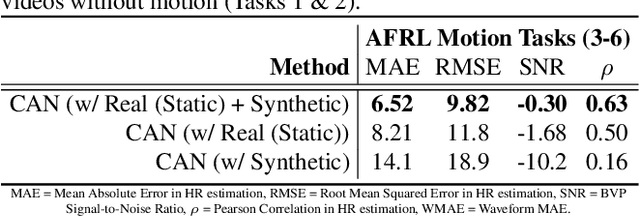
Abstract:Non-contact physiological measurement has the potential to provide low-cost, non-invasive health monitoring. However, machine vision approaches are often limited by the availability and diversity of annotated video datasets resulting in poor generalization to complex real-life conditions. To address these challenges, this work proposes the use of synthetic avatars that display facial blood flow changes and allow for systematic generation of samples under a wide variety of conditions. Our results show that training on both simulated and real video data can lead to performance gains under challenging conditions. We show state-of-the-art performance on three large benchmark datasets and improved robustness to skin type and motion.
A high fidelity synthetic face framework for computer vision
Jul 16, 2020



Abstract:Analysis of faces is one of the core applications of computer vision, with tasks ranging from landmark alignment, head pose estimation, expression recognition, and face recognition among others. However, building reliable methods requires time-consuming data collection and often even more time-consuming manual annotation, which can be unreliable. In our work we propose synthesizing such facial data, including ground truth annotations that would be almost impossible to acquire through manual annotation at the consistency and scale possible through use of synthetic data. We use a parametric face model together with hand crafted assets which enable us to generate training data with unprecedented quality and diversity (varying shape, texture, expression, pose, lighting, and hair).
GazeDirector: Fully Articulated Eye Gaze Redirection in Video
Apr 27, 2017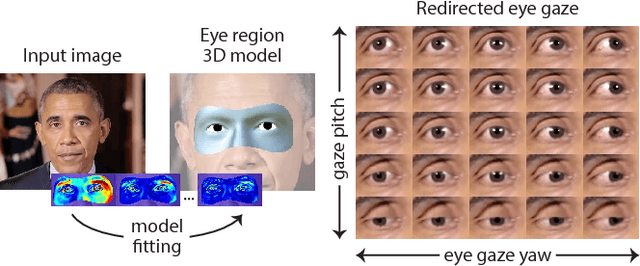
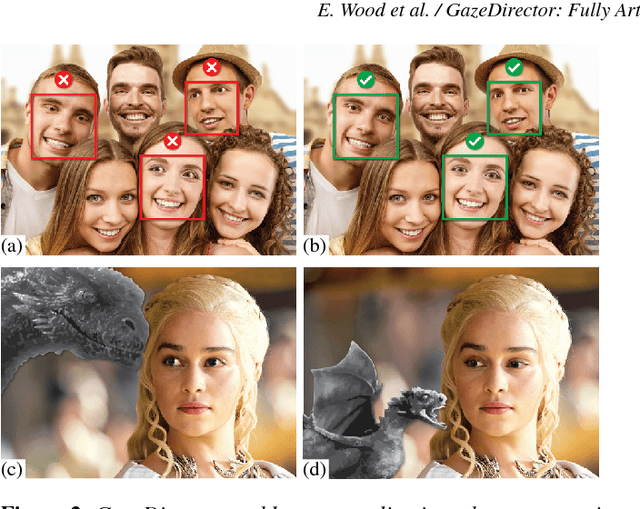

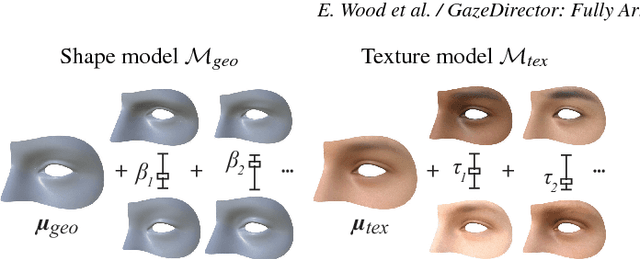
Abstract:We present GazeDirector, a new approach for eye gaze redirection that uses model-fitting. Our method first tracks the eyes by fitting a multi-part eye region model to video frames using analysis-by-synthesis, thereby recovering eye region shape, texture, pose, and gaze simultaneously. It then redirects gaze by 1) warping the eyelids from the original image using a model-derived flow field, and 2) rendering and compositing synthesized 3D eyeballs onto the output image in a photorealistic manner. GazeDirector allows us to change where people are looking without person-specific training data, and with full articulation, i.e. we can precisely specify new gaze directions in 3D. Quantitatively, we evaluate both model-fitting and gaze synthesis, with experiments for gaze estimation and redirection on the Columbia gaze dataset. Qualitatively, we compare GazeDirector against recent work on gaze redirection, showing better results especially for large redirection angles. Finally, we demonstrate gaze redirection on YouTube videos by introducing new 3D gaze targets and by manipulating visual behavior.
 Add to Chrome
Add to Chrome Add to Firefox
Add to Firefox Add to Edge
Add to Edge